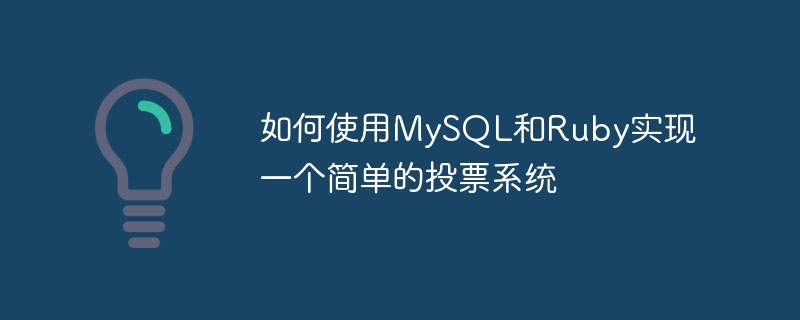

How to implement a simple voting system using MySQL and Ruby
A voting system is a common online application used to collect user opinions on a certain issue or topic Views. In this article, we will introduce how to use the MySQL database and the Ruby programming language to implement a simple voting system.
First, we need to prepare the environment. Make sure you have installed the MySQL database and have a Ruby programming environment. If it is not installed yet, you can download it from the official website and follow the instructions to install it.
Next, we need to create a database. Open the MySQL terminal or use a graphical interface tool (such as PhpMyAdmin) to create an empty database named "voting_system". Create a table named "votes" under this database to store voting information. The table should contain the following fields:
Run the following SQL statement in MySQL to create the table:
CREATE TABLE votes ( id INT PRIMARY KEY AUTO_INCREMENT, question TEXT, option1 TEXT, option2 TEXT, option1_votes INT DEFAULT 0, option2_votes INT DEFAULT 0 );
Next, let’s use Ruby to connect to the database and implement Voting system functionality. First, we need to install Ruby's MySQL driver gem. Run the following command in the command line to install:
gem install mysql2
Then, create a Ruby file, such as "voting_system.rb", and use the following code to connect to the MySQL database:
require 'mysql2' # 创建数据库连接 client = Mysql2::Client.new(:host => "localhost", :username => "root", :password => "your-password", :database => "voting_system") # 添加投票 def add_vote(question, option1, option2) query = "INSERT INTO votes (question, option1, option2) VALUES ('#{question}', '#{option1}', '#{option2}')" client.query(query) puts "投票问题:#{question},选项1:#{option1},选项2:#{option2},已添加" end # 获取投票信息 def get_votes query = "SELECT * FROM votes" result = client.query(query) result.each do |row| puts "投票ID: #{row['id']}" puts "问题: #{row['question']}" puts "选项1: #{row['option1']}" puts "选项1票数: #{row['option1_votes']}" puts "选项2: #{row['option2']}" puts "选项2票数: #{row['option2_votes']}" puts " " end end # 投票 def vote(vote_id, option) query = "UPDATE votes SET #{option}_votes = #{option}_votes + 1 WHERE id = #{vote_id}" client.query(query) puts "投票ID:#{vote_id},选项:#{option},已记录" end # 示例代码 add_vote("你喜欢吃水果吗?", "喜欢", "不喜欢") get_votes vote(1, "option1") get_votes
In the above example In the code, we define several methods to implement the functions of the voting system. The "add_vote" method is used to add voting questions and options to the database, the "get_votes" method is used to obtain all voting information in the database, and the "vote" method is used to record the user's voting choices.
Save and run the "voting_system.rb" file, you will see the voting information printed on the console, and the voting data will be updated.
Through the above steps, we successfully used the MySQL database and Ruby programming language to implement a simple voting system. You can modify and extend the code as needed, such as adding more options, voting statistics, etc. Hope this article is helpful to you!
The above is the detailed content of How to implement a simple voting system using MySQL and Ruby. For more information, please follow other related articles on the PHP Chinese website!




